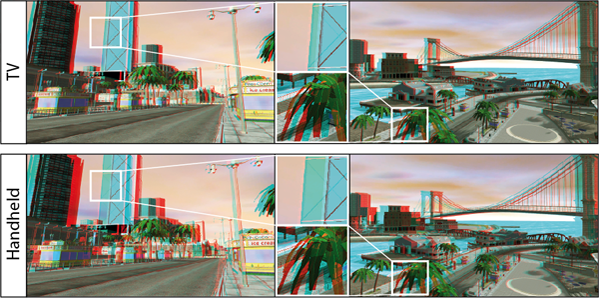OSCAM - Optimized Stereoscopic Camera Control for Interactive 3D
T. Oskam, A. Hornung, H. Bowles, K. Mitchell, M. GrossProceedings of ACM SIGGRAPH Asia (Hong Kong, China, December 12-15, 2011), ACM Transactions on Graphics, vol. 30, no. 6, pp. 189:1-189:8
Abstract
This paper presents a controller for camera convergence and interaxial separation that specifically addresses challenges in interactive stereoscopic applications like games. In such applications, unpredictable viewer- or object-motion often compromises stereopsis due to excessive binocular disparities. We derive constraints on the camera separation and convergence that enable our controller to automatically adapt to any given viewing situation and 3D scene, providing an exact mapping of the virtual content into a comfortable depth range around the display. Moreover, we introduce an interpolation function that linearizes the transformation of stereoscopic depth over time, minimizing nonlinear visual distortions. We describe how to implement the complete control mechanism on the GPU to achieve running times below 0.2ms for full HD. This provides a practical solution even for demanding real-time applications. Results of a user study show a significant increase of stereoscopic comfort, without compromising perceived realism. Our controller enables "fail-safe" stereopsis, provides intuitive control to accommodate to personal preferences, and allows to properly display stereoscopic content on differently sized output devices.Overview
In stereoscopic content creation for real-time interactive applications, one faces a number of challenges. For example, in a first-person game where the player is in control of the view, a simple collision with a wall or another object will result in excessive disparities that cause visual fatigue or destroy stereopsis (see Figure 1). In order to guarantee proper stereoscopy, one needs a controller that adjusts the disparities automatically to adapt to unforeseen scene depth changes.
To control perceived depth efficiently and robustly, this work is looking for an exact mapping of any specific range of distances in the scene into a depth volume around the screen. We achieve such a mapping by geometrically deriving constraints on the stereoscopic parameters, namely the camera separation and convergence. These constraints alow an exact and computatinally cheap solution to control the range of disparities for any arbitrary scene content. Additionally, we show a novel approach of interpolating the stereo parameters over time in order to properly cope with discontinuous scene depth changes.
Results
Our controller has a variety of benefits for interactive stereoscopic applications. Given the viewing geometry (screen size, viewing distance) we can map any scene content into a specific target depth range. This means that the content created by a producer is guaranteed to create the desired stereoscopic depth effect independent of the actual display device, be it for example a large polarized display or a small Nintendo 3DS (see Figure 2). Moreover, an application can be easily adapted to the depth or disparity constraints of a particular device, which helps to reduce ghosting or crosstalk artifacts.When moving the camera through a scene, the render-depth is constantly changing. Improper camera convergence and interaxial separation can cause large disparity values when an obstacle suddenly comes close to the camera. An example is shown in Figure 1, where a player is moving fast through the environment. While our method is able to adapt to vast depth changes, uncontrolled stereoscopy causes excessive disparities and hence induces eye-strain to the viewer.
Our method also provides intuitive and exact stereoscopic control by allowing the viewer to adapt the perceived borders of the depth range to the respective personal comfort zone. The user can also define high-level goals for the depth. The viewer may specify to move or scale the target depth image, without worrying about the exact depth values or the stereoscopic camera parameters. OSCAM also provides an interesting tool for content creators and artists in production. Our controller can be used to intuitively script perceived depth for different scene parts and hence create artistic effects such as emphasized depth for certain objects, stereoscopic flatlands, etc.




